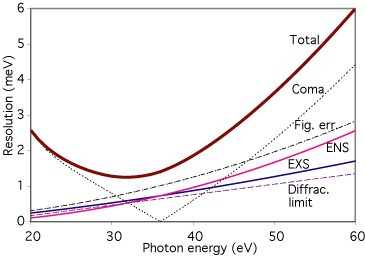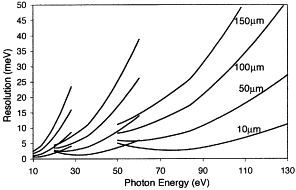The SGM 3 beamline at ASTRID
Note that the SGM3 beam line was transferred to ASTRID2 in 2014. You can read more about the beamline and current activities here.
The Monochromator.
The SGM III beamline is designed to operate in the 12–130 eV photon energy range with a resolving power of around 15.000. This energy range is covered with three spherical gratings and by using the first and third harmonic of the undulator inserted in the ASTRID storage ring.
A schematic outline of the beamline is shown in Fig. 1, and the optical parameters and distances are given in the table. The design of this monochromator follows to a large extent the design of the ASTRID SGM2 monochromator

Figure 1: Schematic outline of the beamline design
| Optical Element | Distance from undulator centre(mm) |
Optical parameters |
Angle to normal (deg.) |
|
| HFM | Horizontal focusing mirror | 6500 | Spherical R = 147.000 mm |
85.75 |
| VFM | Vertical focusing mirror | 7500 | Spherical R = 46.000 mm |
80.5 |
| ENS | Entrance Slit | 7900 | ||
| G | 3 gratings | 9650 | Spherical R = 13.25 mm 410 l/mm 1025 l/mm 2500 l/mm |
77.5 |
| EXS | Exit Slit | 13,550-14,050 | ||
| TPM | Focusing mirror | 18,650 | Toroidal R = 32.200 mm ρ = 380 mm |
84 |
| Sample | 21,150 |
Table: Optical elements of the beamline
The beamline consists of a spherical horizontal focussing mirror (HFM), a spherical vertical focussing mirror (VFM) which focussed the beam into an entrance slit (ENS), up to three interchangeable spherical gratings, a moveable exit slit (EXS), and a toroidal mirror (RFM), which re-focuses the beam onto the sample. The choice of spherical elements facilitates the alignment of the pre-focussing elements (HFM and VFM). Given the size of the electron beam in ASTRID (root mean square, r.m.s., 1.45 mm horizontally and 0.23 mm vertically) then the optical aberrations of a toroidal mirror do not degrade the final image on the sample (typically 0.5 mm vertically, and 1 mm horizontally).
The short distance between the VFM and the ENS (400 mm) ensures a high demagnification of the beam, increasing the flux through the entrance slit. As mentioned earlier, the small divergence of the undulator ensures that despite the large demagnification, then the image is not seriously degraded by optical aberrations.
The monochromator is operated in the first inside order, with an entrance slit to grating distance of 1750 mm. The included angle and line density of the low energy grating (LEG), the medium energy grating (MEG) and the high energy grating (HEG) are chosen to cover energy ranges of 10-27 eV, 22-60 eV and 55-130 eV respectively. A possible movement of the exit slit by 500 mm is more than sufficient to keep the slit in focus over the energy ranges of the three gratings. The laminar profile of the grating was designed to optimize the 1 order diffraction efficiency, while suppressing the 2nd and 3rd order radiation. The separate contributions to resolution from the slits, grating figure slope error, diffraction limit and primary coma are shown in Figure 2 for the medium energy grating with an ultimate smallest slit setting of 10 m. Figure 3 shows the total calculated resolution using different slit settings.

Figure 2: Contributions from the entrance slit (ENS), exit slit (EXS), grating figure
slope error, primary coma, and diffraction
limit to the total resolution of the medium energy grating of SGM3

Figure 3: Total resolution of SGM3 for four different slit settings.
The ARPES Experimental chamber.
This beamline is combined with an end-station for angle-resolved photoemission. The spectrometer is a 75 mm mean radius hemispherical electron energy analyzer which is mounted on a goniometer within the ultra-high vacuum chamber. The motions of the analyzer and several settings of the beamline are motorized and computerized scans can be performed. The system is in particular well suited for measurements of the electronic structure along arbitrary lines in k|| space, Fermi surface mapping and studying the polarization dependence of photoemission features
The primary area of interest is valence band studies. For these studies the experimental chamber is equipped with
- 75mm hemispherical analyser on motorised two-axis goniometer
- energy resolution: better than 15 meV
- variable angular resolution
- multi channel detection
- cryo-cooling of the sample
- preparation chamber
More information regarding the SGM3 beamline and a more detailed description of the ARPES experiment please see:
Or contact:
Beamline: Søren Vrønning Hoffmann
ARPES experiment: Philip Hofmann
Last Modified 25 October 2022